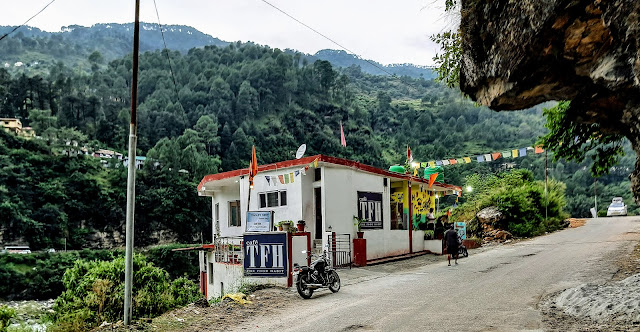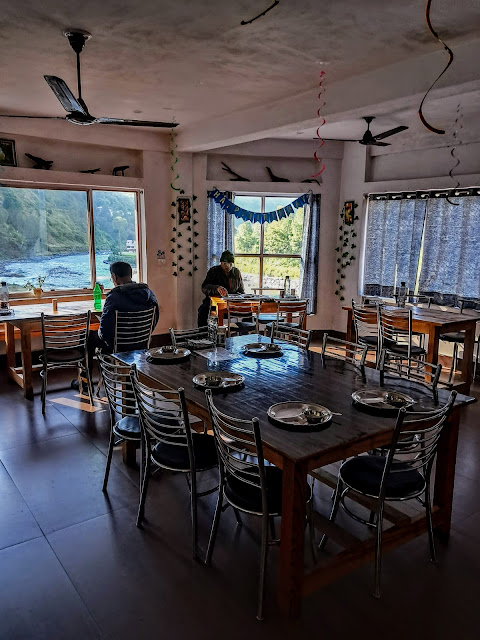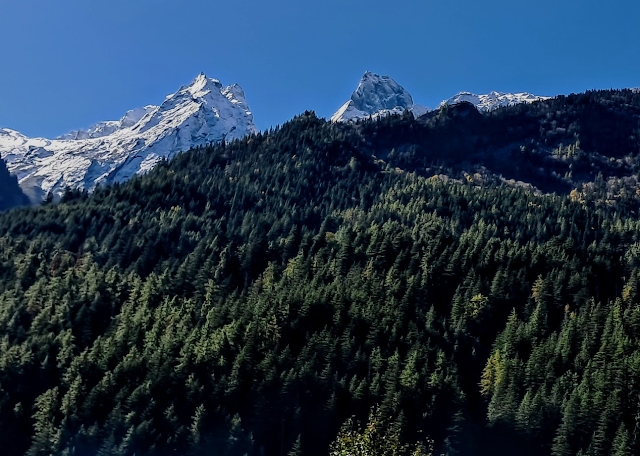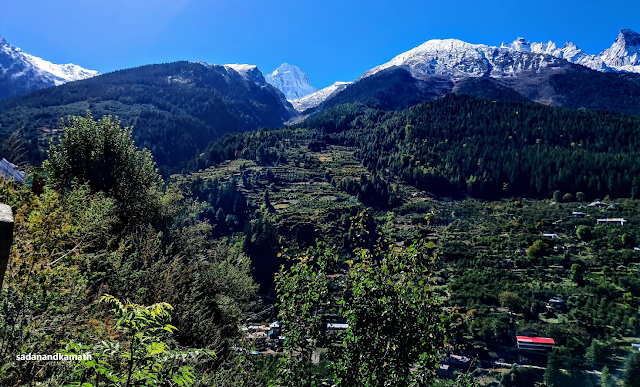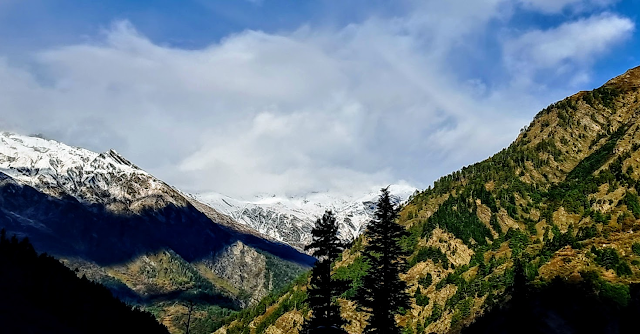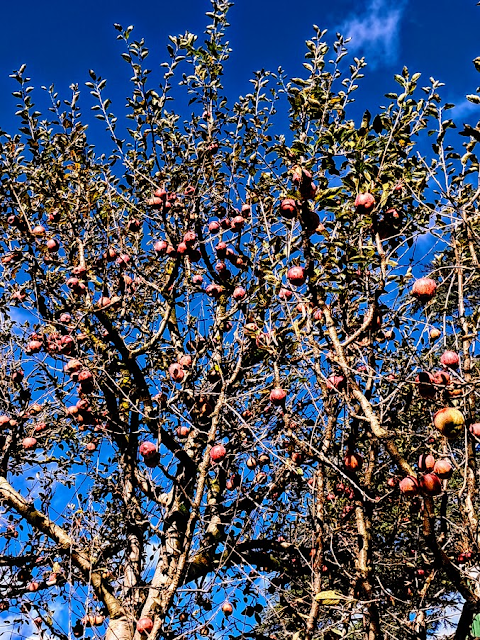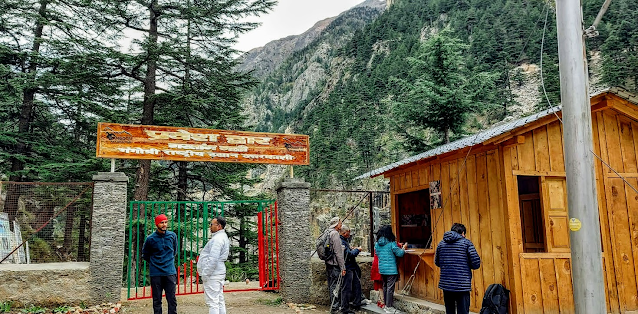October 11, 2022
I was fascinated by the picture of Gartang Gali which I first saw in an article written by Romesh Bhattacharjee in 'Frontline' in early 1990s of his team's expedition to Jadh Ganga Valley. It was my dream to get the thrill of walking on the wooden staircase constructed on a vertical mountain cliff and watch the flowing blue water of Jadh Ganga River, 200-300m below the staircase. But it was not to be as the place was restricted for civilians. Also due to neglect of the wooden staircase after its closure in 1962 following Indo-China war, it was risky to walk over the wooden staircase as some places, the wooden planks were damaged. So, for the past 30 years, the walking on the wooden staircase remained a dream. I had resigned to the fate that I will not get the opportunity to walk on the Gartang Gali during my remainder of the life.

Gartang Gali wooden stairs as it existed in 2018, that is, before the completion of its renovation in 2021. Photo by Neeraj Musafir sourced from 'Musaafir Hoon Yaaron' Blog.
Thanks to Uttarkashi-based Tilak Soni of Eagle's Nest who made concerted efforts to convince the Uttarakhand Government's administrative machineries to renovate the damaged portion of the wooden stairs and open it to the tourists. His efforts bore fruits and the PWD of Bhatwari Block of Uttarkashi district undertook the repairs work which started in September 2020. The labourers and carpenters worked under very harsh weather conditions. They were tied with safety ropes while doing renovation works. The work was completed in July 2021, and it was reopened to the tourists in August 2021 after a gap of 59 years.
It was a great news for me. So, I had included one day for trek to Gartang Gali in my itinerary of ramblings in Uttarkashi district. Today was my D-Day. We checked out of GMVN, Harsil and hired a Bolero to take us to Lanka Bridge (it is also called Bhaironghati bridge) for onward trek to Gartang Gali. The Bolero will wait for us to take us to Gangotri and return to drop us back to our new abode in Harsil for 2 nights.
Our Cottage in GMVN, Harsil by the side of Bhagirathi River.
We left Harsil at around 09.00 a.m. and drove on the Gangotri road. In 45 minutes, we reached the forest check post of Gangotri National Park located close to Lanka bridge. We registered our names with Aadhar Cards numbers and paid the entry fee of Rs.150/- per head. When we commenced our trek, the weather had turned cloudy. But there was no likelihood of rainfall immediately as the clouds were hanging at a higher level than what we usually observe of rain bearing clouds. I took this weather condition a blessing in disguise as the sunrays in the Jadh Ganga Valley and shades on the trekking path due to forest coverage would have rendered difficult to adjust the light while taking pictures. In cloudy weather, the lights are equally distributed to avoid distortions in light coverage. In this condition, we would get the true water colour of Jadh Ganga River.
I am in the queue for registration for Gartang Gali trek at Forest Check Post near Lank bridge.
Photo by K Srinivasan.
Starting point of Gartang Gali trek.
Genesis of Gartang Gali Trek Route
Prior to 1962 Indo-China war, people of Nelong and Jadang villages used to undertake cross-border trade with Tibet. They will sell Indian goods bought from the markets of Uttarkashi and surrounding towns and sell to their Tibetan counterparts in exchange of goods produced in Tibet. It was a barter trade. People of Nelong and Jadang villages had to carry goods bought from the Indian side markets through Bhaironghati-Nelong pedestrian path which was the shortest route to Nelong village for onward journey to Tibetan border.
Due to vertical mountain in enroute, the extremely narrow path would sometime result in deaths both for men and the animals carrying the goods. Some rich traders of Nelong Valley decided to take the help of Peshawar Pathans who were experts in constructing the path on such topography as they had done such works in Khyber Pass. So, about 150 years ago, the Peshawar Pathans constructed the wooden stairs in Jadh Ganga Valley (also called Nelong Valley) by cutting the rocks of the vertical mountains by hammers and chisels and placing on the rock-cut surface, the wooden planks on which the wooden stairs were fitted.The wooden railing was also raised so that there is support for men and animals in case they lose balance.
The 1962 Indo-China war changed this situation. The cross-border trade with Tibet was stopped. The Indian army vacated people from all the villages bordering with Tibet like Nelong and Jadang. People from these villages were settled in Bagori village near Harsil. When there was no more cross border trade and no one in the border villages, this route remained virtually closed except for the Indian Army personnel. Even that too got stopped as a new road from Bhaironghati for Nelong was constructed which became operational in 1975.
Trek path on the left and Jadh Ganga River on the right below.
On the way to Gartang Gali
Two JCBs clearing the rock debris on the road to Nelong on the opposite mountain.
The Lanka iron bridge over Jadh Ganga River on Gangotri Road seen from Gartang Gali trek.
Descend towards Gartang Gali staircase.
Gartang Gali is also the corridor for Himalayan Blue Sheep (Bharals).
The forest/PWD authorities seem to have done a very good work in restoring the trek path which had remained unused for 59 years. Probably, they may have cleared landslides and rockfalls accumulated over the years. The path is now smooth for an easy walk on dry days. The climb is gradual till half-way (about 1 km) after which there is a stiff descend of less than 1 km to reach the starting point of the walk on the wooden stairs.
When we reached at the starting point of wooden stairs, the cloudy weather has turned into possibilities of rain showers. So, we hurried up to commence the walk on the wooden stairs. The board at the starting point of walk on wooden stairs put up by the Gongotri National Park has laid down the conditions for the use of wooden stairs. They are:
1. Not more than 10 persons at a time should be on the wooden stairs.
2, The distance between two persons walking should be one metre.
3. No crowding while walking or sitting on the stairs.
4. No person will bend over the wooden railing to see the river below.
It was a great feeling for me when I put my first step on the wooden stairs which were initially like a ramp rather than 'step-down' stairs. At that very moment, a light drizzle started as if showering flower petals on my way on the wooden stairs for a grand welcome in Gartang Gali. The drizzle continued until we completed our walk on wooden stairs part of the trek.
The start of Gartang Gali staircase with Jadh Ganga River flowing on the right.
My dream of walking on wooden stairs becomes a reality with Jadh Ganga flowing on the right side.
The long shot of the corridor of Gartang Gali wooden steps. The light drizzles welcome me on the wooden steps, On the right is Jadh Ganga River.
The hanging rock over wooden stairs.
KS and Me sitting on the freshly renovated wooden steps with hanging rock over our heads.
The end of the trek beyond which no one is allowed to cross this point.
On the half-way on the wooden stairs, the ramp turned into stair steps as the descend started. After about less than 200 metres from the starting point, the wooden stairs ended and also the end point to our trek as the further path was barricaded. With the availability of road to Nelong on the opposite side of the mountain, there is no need for anyone to use this route now. Probably, as a part of adventure tourism, some more parts of this route further to wooden stairs can be opened for trekkers as a day trek. We returned to Forest Check Point at Lanka bridge in 45 minutes to be ready for our further journey to Gangotri.
The return journey.
This is one of the hanging parts of Gartang Gali. This is also a point at which trekkers have to bend while walking to avoid 'head collision' with the hanging rock.
End of the trek at Forest Check Post. On the right is Lanka bridge on Gangotri road to right.
Drive to Gangotri
The weather was turning bad as we returned to Lanka. So, without wasting much time, we started our road journey to Gangotri which was about 10 kms of distance. Since this entire road journey passes through mountains of loose rocks/stones with mud, even moderate rains can trigger rock/mud slides blocking the road. As we approached Gangotri, we found to our dismay that buses and SUVs ferrying pilgrims have been parked about 2 kms from the gate of the Gangotri temple signaling that the Gangotri temple premises would be crowded. To our bad, the intensity of rains increased forcing me to take out my umbrella. Somehow, our driver could find a parking place within 1 km of the gate. We walked to the temple in rains jostling with the crowd of returning pilgrims from Gangotri temple. Fortunately, when we reached the temple, the pilgrim crowd thinned out, the reason being Gangotri temple closes for 1 hour in the afternoon. One can, however, have darshan through the collapsible door from outside.
Jadh Ganga River gorge clicked from Lanka bridge.
At Gangotri temple in rains.
Gangotri temple in rains.
Since the rains were not abating, we decided to drive back to Harsil after spending about 30 minutes in the premises of Gangotri temple. We took a lunch break of about 1 hour in a dabha located close to Lanka bridge. In our return road journey, we faced intermediate rains. We reached at 3.30 p.m. to our new abode for next two nights, Sundar Homestay in Harsil and felt relieved from rains.
KS standing in the balcony of our room in Sundar Homestay, Harsil.
View of the flower garden of Sundar Homestay from our room balcony.
Evening view from the Harsil market.By evening, the rains had abated, and it was the time for us to move out of the room. We decided to take a round of Harsil Market and have the evening tea as well. It was a good walk giving us the opportunity to take some pictures. It appears that the higher reaches of the mountains surrounding Harsil had good snowfall when it was raining in the afternoon. We returned to our room as the dusk turned into night. We had a good and tasty home food for dinner in the dining room of our homestay before we retired for the day.





